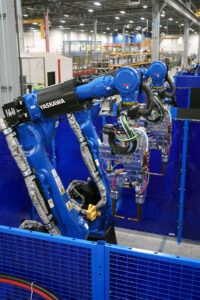Fast cycle times, efficient floorspace utilization and user-friendly production tools are all necessary for spot welding success. When it comes to the latter, there are several solutions that help manufacturers maximize the benefits that robotic automation can bring to the resistance welding process. With that in mind, here are some spot welding robotic technology “must haves”:
High-Performance Robots
Quick axis speeds and acceleration capabilities are key to reducing air-cut time and achieving faster cycle times. Spot welding robots like Yaskawa’s SP-series family of robots are ideal to meeting production and reliability goals, while GP-series robots can be used for existing pedestal welders.
Space-Saving Tools
 Floorspace utilization can often make or break competitive edge. Highly flexible seven-axis robots such as the SP100B are specifically designed to maximize floorspace and reach into tight spaces. An expanded range of motion and reduced interference design work together to expertly accommodate high-density workcells. Similarly, six-axis robots like the SP80 or SP165 also offer slim profiles to facilitate product line layout flexibility.
Floorspace utilization can often make or break competitive edge. Highly flexible seven-axis robots such as the SP100B are specifically designed to maximize floorspace and reach into tight spaces. An expanded range of motion and reduced interference design work together to expertly accommodate high-density workcells. Similarly, six-axis robots like the SP80 or SP165 also offer slim profiles to facilitate product line layout flexibility.
Pre-engineered workcells, like those based on our ArcWorld® series, are also helping manufacturers solve floorspace dilemmas. Robust robots, positioners and process equipment are easily combined with the proper safeguarding on a space-efficient base. Automotive, agriculture, construction manufacturers and more find that these workcells offer a more affordable way to save on cycle time and resources.
Robust Positioners
A wide range of servo positioners exists to provide the speed and reliability needed to get jobs done quickly with the utmost accuracy. From single-axis positioners to three-motor trunnion positioners, and more, a variety of durable options exists to facilitate peak performance.
Manufactured to the same exacting standards as our robots, Yaskawa positioners are built to perform for the toughest applications. A patented MotoMount™ fixture mounting system allows positioners to be lagged directly to the floor, increasing positioner life and improving weld repeatability. It also simplifies tooling for faster and easier changeover. Multi-tasking software facilitates coordinated motion control between all multi-axis positioners, robots and base axes from a single primary controller and programming pendant.
Servo Guns
Leading spot gun manufacturers like OBARA and ARO work hard to provide their customers with the lightest, most efficient and versatile welding equipment for any material or part size. More energy efficient than pneumatic guns driven with compressed air, today’s servo spot welding guns help:
- Minimize electrode wear, resulting in increased uptime
- Provide consistent clamping force, improving quality
- Eliminate “squeeze time” wait for an air-gun to close, resulting in reduced cycle time
Comprehensive spot welding packages bring all of this to fruition and typically include:
Robust software: spot guns integrated with Advanced Robot Motion (A.R.M.®) control software maximize performance by providing easy calibration for X- or C-type spot guns. They also automate offset for gun arm deflection and tip wear compensation. Furthermore, stepped pressure files allow the spot gun pressure to be varied during the weld cycle, as well as during a tip dress cycle.
 Integrated spot gun harness: the spot welding harness improves throughput by eliminating downtime due to robot harness issues and simplified programming. Product launch times can be reduced via simulation and offline programming, versus editing programs to avoid cable interference. New hollow-arm robots increase these benefits even more, and they are equipped with the proper sized wiring for aluminum spot guns.
Integrated spot gun harness: the spot welding harness improves throughput by eliminating downtime due to robot harness issues and simplified programming. Product launch times can be reduced via simulation and offline programming, versus editing programs to avoid cable interference. New hollow-arm robots increase these benefits even more, and they are equipped with the proper sized wiring for aluminum spot guns.
Efficient servo spot guns: spot gun manufacturers keep packing greater spot gun capability into a smaller system. Transformer sizes have been greatly reduced by using mid-frequency inverters for DC welding. And, higher frequency inverter switching (1,800 to 2,000 Hz) help reduce gun size and weight.
Spot timer digital interface: digital interfaces for spot timers, such as the ones offered by Medar® and Nadex®, allow programming from the robot teach pendant. For the Medar MedWeld 6000 timer, the ability to program and monitor information is also provided with up to to 255 weld programs supported (for each timer). Likewise, up to four timers can be networked with a multiple robot controller.
Overall, all of these technologies work together to provide feature-rich operation that yields transformative results. To learn more on how these items can positively impact your shop floor, contact our experts today!








































